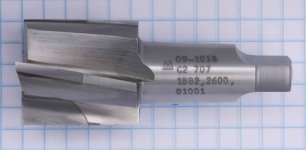chiniak1955
Plastic
- Joined
- Aug 20, 2008
- Location
- Oregon
I am trying to identify the short taper on this end mill, with the hope of acquiring a holder I can use in a R8 machine. I have several and know where a lot more are.
Data: 3” OA, shank is 1.5”, ground taper is 1.125" from top of flute to bottom of tang, big end at top of flute is 0.700”, small end below tang is 0.650”
Marked: 09-1014,C2 707,1882,2600,01001 The makers mark is an outlined “M”.
Any insights?
Data: 3” OA, shank is 1.5”, ground taper is 1.125" from top of flute to bottom of tang, big end at top of flute is 0.700”, small end below tang is 0.650”
Marked: 09-1014,C2 707,1882,2600,01001 The makers mark is an outlined “M”.
Any insights?


